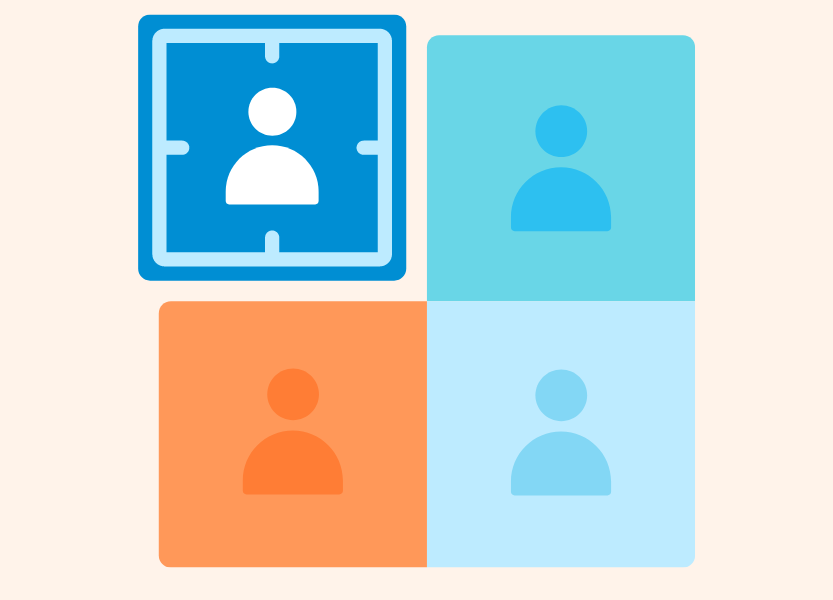
Italian economist Vilfredo Pareto once observed that 20% of the population owned 80% of Italy’s land. This seemingly simple observation led to the “Pareto Principle” or “80/20 rule.”
Translate that to customer segmentation: 20% of your customers could generate 80% of your profits. Or, as Drew Sanocki, Founder of Nerd Marketing, terms them, these are your “whales”—the crème de la crème of your customer base.
Your move? Identify and nurture that 20% of highly profitable customers with customer segmentation tactics.
Table of contents
Why Segment Customers?
Every customer has a pattern that reflects their purchase behavior. When you segment customers, you effectively decode these patterns to transform data points into actionable insights.
“If you’re not segmenting and targeting your customers, you waste time, energy, and unnecessary work. You’re really leaving money on the table.” — Drew Sanocki
Segmenting customers enables you to tailor your offerings, communication strategies, and services to meet individual needs, creating a more meaningful connection between your brand and customers. Customer segmentation isn’t just about selling more efficiently; it’s about serving more effectively.
“Customer segmentation analysis helped me understand our business better, improve all our KPIs and communicate better with our customers.” — ECF Member
Why Customer Segmentation Matters
- Personalization: Tailor your messaging to fit individual needs and preferences.
- Optimized Marketing Spend & ROI: Direct resources to high-value customer segments for maximum returns.
- Customer Retention: Retaining your biggest brand advocates or converting “minnows” to whales.
- Product Insights: Guide product development based on specific customer segment needs.
- Pattern Recognition: Understand and anticipate buying behaviors to inform your customer segmentation strategy.
- Channel Strategy: Adapt messaging and tactics for each marketing channel based on segment behavior.
Remember, customer segmentation isn’t just about demographics (age, gender, income) or psychographic segmentation (lifestyle, personality); it’s also about customer relationships and understanding their value to your business, particularly when identifying and nurturing your whales.
The Power of ‘Whales’ in Your Customer Segmentation Analysis ?
Drew Sanocki emphasizes the recency and frequency of transactions using the RFM model when approaching your customer segmentation analysis.
By leveraging this, you can fine-tune your customer segmentation strategy to resonate more with your high-value customers— or, as Drew terms them, “whales.”
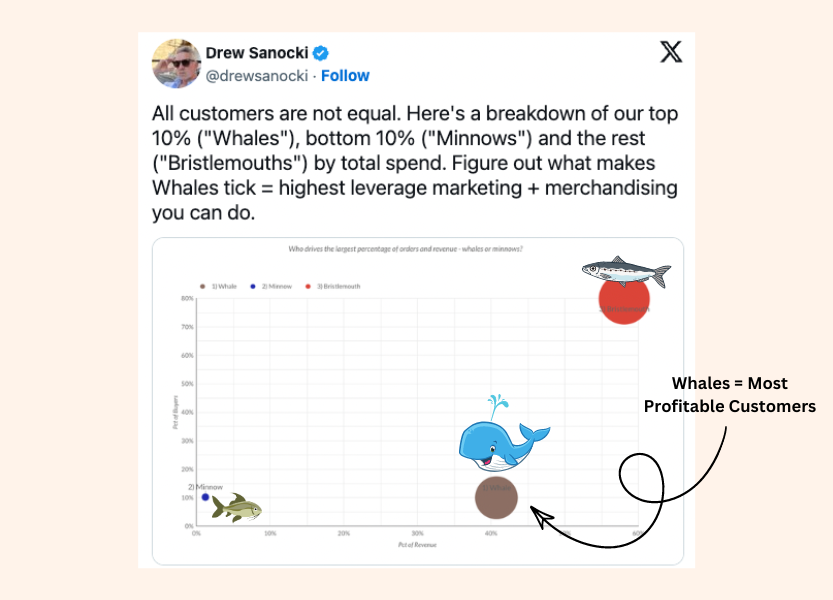
Here’s a breakdown of how this customer segmentation model works across acquiring, retaining, and developing your “whales.”
Growing Whales Through Acquisition
Detect patterns in acquisition sources to find where most whales are coming from. For example, comparing Google Ads with Meta Ads could reveal which platform is better for attracting whales.
This customer data detection isn’t strictly limited to platforms but can drill down to ad groups or specific keywords.
Use Google Analytics to understand which sources are drawing in the most whales. For instance, if only 9% of overall traffic is from paid search but 22% of whale traffic is from paid search, it indicates that paid search is a gold mine for whales, and you should consider investing more in that channel.
Drew recommends logging marketing attribution information with each order to make this kind of analysis possible later.
Retaining the Whales
Drew recommends two marketing strategies for retaining high-value “whale” customers.
- First, focus on identifying and promoting products that attract these valuable customers rather than just high-conversion products.
- Second, implement targeted win-back campaigns based on the average time between purchases.
Converting Occasional Buyers into Whales
Drew recommends a targeted product strategy for converting occasional buyers into high-value “whale” customers.
In the case of a women’s apparel retailer, bras served as a ‘bridge product’ that led customers to purchase higher-priced items.
The company capitalized on this customer segment by prominently featuring bras on its website and in newsletters, successfully converting more ‘minnows’ into ‘whales.’
However, Drew also cautions that “good customers are born, not bred,” suggesting that while there’s value in attempting to convert low-volume buyers into high-volume ones, it might be more efficient and profitable to focus on acquiring and retaining naturally high-volume buyers.
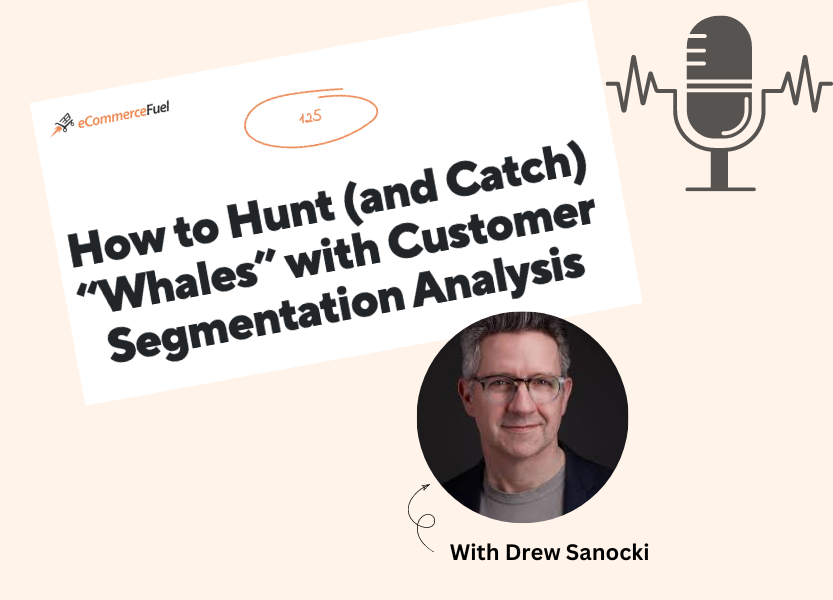
Check out the full ECF podcast here.
Preparing for Segmentation: What Do You Want To Achieve By Segmenting Your Customers?
Before diving into the types of customer segmentation, ask what are you trying to accomplish.
“Don’t pull levers just because you can. It’s like the cockpit of a plane, unless you know what outcome you want, you don’t want to start pushing all the buttons just to see what happens.” — ECF Member
Your objectives—be it personalized marketing, enhanced customer experience, or product development—will guide your customer segmentation model, marketing team, and strategy.
Should Buyer Personas Precede Customer Segmentation?
The answer is no. Instead, customer segmentation can help you improve your buyer persona development. The truth is: many marketers use irrelevant data, solely relying on assumptions, or idealized views to group customers, resulting in inaccurate personas.
A detailed persona needs to be grounded in real customer insights. It requires talking to your customers in-depth and collecting behavioral and psychographic data on their buying triggers, responsibilities, rituals, frustrations, emotional aspirations, goals, etc. It’s not about debating what their favorite show is to watch on the weekend.
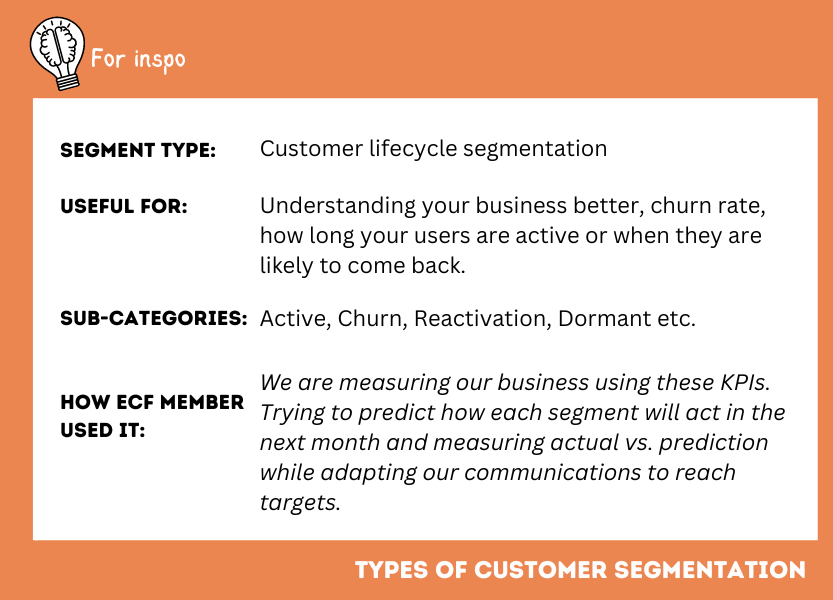
While the RFM model offers a sturdy framework for identifying profitable customers, it’s not the end-all.
Tried-and-tested Methods for Segmentation ?
With the help of the ECF community, we’ve compiled some of the best customer segmentation strategies you can use to apply customer segmentation to your business.
Note: These aren’t sequential steps but individual tactics to begin or improve your customer segmentation processes.
Gathering Insights Directly with Surveys, Forms & Customer Interviews
Here are three examples of brands within the ECF community that optimized their customer segmentation process using surveys, in-depth interviews, or a Google Form to go straight to source; the customer.
Surveys ?
Surveys are a straightforward and efficient way to gather customer insights. When crafting your surveys, use questions that directly impact business decisions or inform strategies.
“Start with 5-7 questions. Keep it brief and multiple-choice. Ask things where there is an actual LEVER YOU CAN PULL -or- DECISION YOU CAN MAKE with the data. Answers should either segment customers, provide insights for merchandising, or help with product dev, etc.” — ECF Member
For this ECF Member, their primary objectives were to:
- Create more relevant content by segmenting their list. While they already segmented behaviorally (like new vs. returning customers), they sought to delve deeper into demographic, psychographic, and desire-driven segmentation.
- Design landing pages tailored to specific customer segments to better optimize ads.
They currently segment customers based on website behavior, such as purchase history and visit frequency. They have demographic data from Google Analytics and Meta Ads but need more profound insights into their customers.
“So going down this path, since we run a sleep accessories company, perhaps the survey questions should focus on finding out what pain points people have around sleep (falling asleep, quality of sleep, insomnia, loud kids, etc.).” — ECF Member
?? Tool highlight: Check out Knocommerce for post-purchase surveys.
Customer Interviews ??
In-depth customer interviews offer qualitative insights that can complement your quantitative survey data. You can better target your offerings and messaging by comprehensively understanding customer needs and pain points.
Another ECF member identified customer segments via persona interviews conducted by Baotris, gathered 10,000 survey responses, and tested multiple emails and flows over two months.
“Previously, our marketing efforts focused on the jewelry aspect of our product, but we found that most of our customers fit better into the categories of astrology-enthusiasts and astrology-curious.” —ECF Member
Baotris helped us map a new purchase journey of current and prospective customers by launching an end-to-end persona-based email marketing flow.
They also developed new foundational email flows to better address the interests of their target audiences, which include both beginner and advanced astrology enthusiasts. To make these emails more appealing, they tested specific language and imagery tailored to this new target audience and enriched the content with added value, such as new products.
This led to a record 35% of total revenue from email campaigns, surpassing all KPIs such as open rates, click-through rates and conversions.
Google Forms ?
Google Forms can be a quick and cost-effective way to validate which variant of a product your customers will buy. And how much they will pay for it.
Google Forms ?
Google Forms can be a quick and cost-effective way to validate which variant of a product your customers will buy. And how much they will pay for it.
One ECF Member (and his brother) bought a struggling Murphy bed business with two product lines: a ready-to-assemble (RTA) bed at $1,500 and a DIY kit at $89.
They launched a “Coming soon” product page and had our customers fill out a Google form to indicate which variant they would buy. Then then tested the interest level at various price points.
“We learned that customers were remarkably interested in our bed at pricing that would be lucrative for us (this had been my big reservation beforehand, and I was flat-out wrong).” — ECF Member
With this information, they revamped the business model to include RTA beds. However, they faced challenges selling DIY kits and RTA beds on one website. Both of them had completely different value props.
After a site revamp led by a conversion expert, they focused solely on RTA beds, which had a more significant market potential. The pivot paid off quickly; within seven months, revenue from the RTA bed alone surpassed the combined revenue of both products. By year’s end, the company grew 293% over the previous year, achieving its first-ever $1M revenue milestone.
Now, they’re executing a similar playbook as before: focusing deeply on our target customer and building out the variant breadth they’re looking for by offering the right sizes, orientations, and finishes.
? Related reading: The eCommerce Pricing Strategy That Made Us 30% More Money
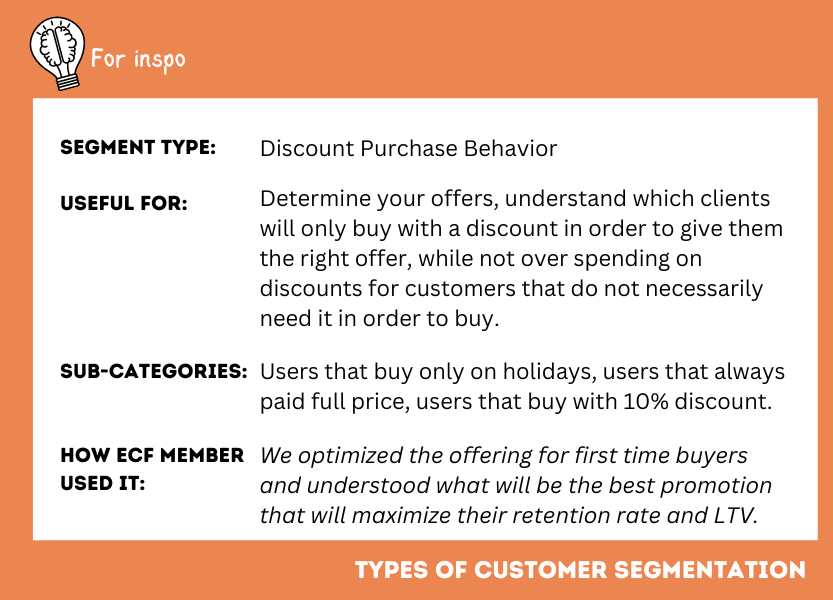
Leveraging Existing Data To Guide Your Customer Segmentation Strategy
Foundational data is often already available to you. By utilizing tools like Google Analytics and Social Media Ad Platforms, you can better understand customer behavior and demographics.
Customer Match Lists ?
If your ad account supports it, Customer Match lists can be a highly effective tool for targeted marketing. It allows you to reach new, potential customers through similar audiences based on your customer match segment.
“In terms of the mechanics, we’ve automated two customer lists that we send to Google: Newsletter subscribers and Purchasers. I want to believe it speeded our PMax machine learning phase as we went from breakeven to slightly profitable in about two weeks from launch, but the ROAS is still not where we want it to be with PMax.” — ECF Member
A service provider on ECF says,” This is part of our best practices. There is also a direct connection with Klaviyo, so you can continuously have updated data.”
Using Third-Party Data ?
Third-party data providers like Experian’s Consumer View and Mosaic compile vast data attributes from various public and proprietary sources.
“You feed in a big dataset (in this case 1MM customers), it triangulates “who” those customers are based on a lot of other datasets (mainly cc purchase behavior) and adds a ton of columns for those behaviors and (via the Mosaic tool) creates LAL audiences on major platforms for targeting.” — ECF Member
?? However, there’s a caveat: It’s expensive, and you can’t keep the data post-engagement. This means you’re renting the data and can’t capitalize on it long-term.
“Yes, $45k sounds crazy, but the other “good” way of doing this is through block-and-tackle interviews, which are expensive, time-consuming, subject to self-selection bias, and required to be repeated for each cohort. Alternatively, with a million customer profiles, I hope that I’ll end up with a granular picture of key cohorts in a very short time.” — ECF Member
Leveraging Specialized Tools and Apps for Enhanced Segmentation
Tip: As a member of ECF, you gain access to our Review Directory to help you find thousands of unbiased reviews and member-only discounts to make better investment decisions.
Customer Quizzes ?
Consider the creative approach of utilizing customer quizzes, as one ECF member did through RevenueHunt.
“We started doing customer quizzes using RevenueHunt – it’s more of a value add for the customer than a survey would be, and we use each Q&A as a marketing opportunity to sell the customer a little more… but it has also given us customer insights! (And the conversion rates after taking the quiz are like 5x higher than average on our site).” — ECF Member
Not only do these quizzes serve as a value-add for the customer, but they also double as a marketing tool.
Streamlined Email Segmentation (with Klaviyo) ?
The concept is simple: Segments will help you send the right emails to the right people.
An ECF member used segmentation to reactivate dormant email segments before Q4 to capitalize on Black Friday and Cyber Monday.
Focusing on users active within the last 30 days, they segmented less-engaged customers into two groups based on their last purchase: 60-180 days and over 180 days ago. These groups received $10 and $20 coupons, respectively. The emails avoided promotional language, leading to a 35% open rate and bypassing Google’s promo tab.
“The re-activation strategy doubled our “Open or Active – 30 Day segment” and generated $10,000+ in sales. Win-win.” — ECF member
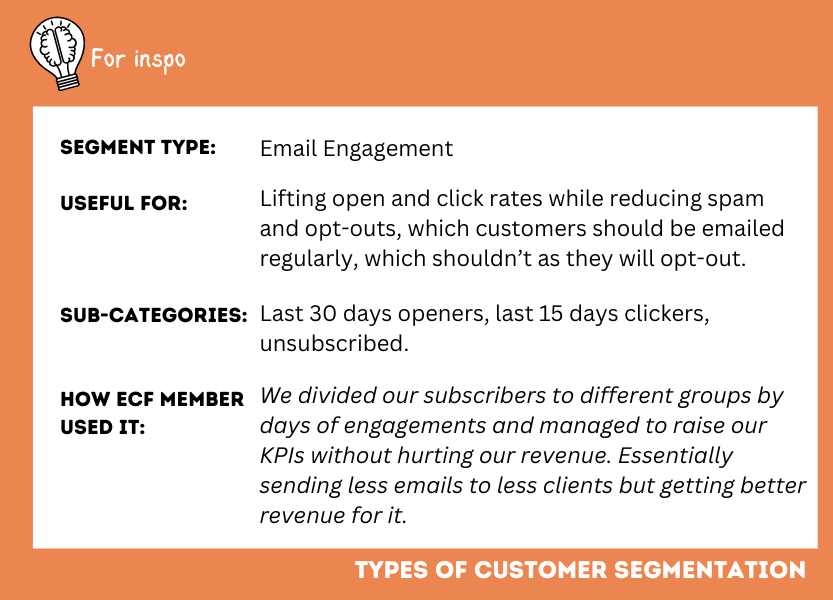
? Read ECF’s Complete Guide to eCommerce Email Marketing to learn how to leverage the power of email to build strong relationships with your customers, increase customer loyalty, and drive sales.
Klaviyo customer segmentation tool allows for highly specific audience targeting based on various conditions, from location to purchase history.
Its real-time data updating ensures that segments are always current, making your marketing efforts more timely and relevant. Klaviyo also allows for enhanced social media ad targeting by syncing with platforms like Facebook and Instagram.
More recently, they’ve just announced Klaviyo’s Customer Data Platform (CDP), which will further enhance customer segmentation by speeding up decision-making and providing quick access to insights. It cuts costs by eliminating the need for multiple tools or custom development.
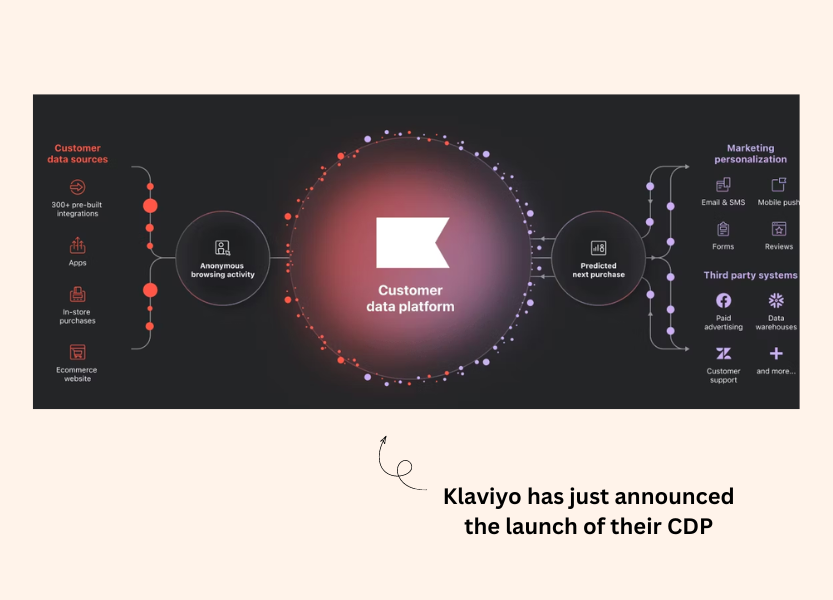
Implementing Your Segments: Activating Your Customer Insights for Maximum ROI
Once you’ve identified and refined your customer segments through various tools and strategies, the next step is to apply these insights practically in your marketing content and website.
Some pointers:
- Ad Campaign Optimization: Design customer-segment-specific landing pages to optimize your ad campaigns. For example, if you’ve identified a segment interested in eco-friendly products, direct them to a landing page featuring your sustainable line.
- Email Personalization: Tailor your email content to resonate with different customer segments. For example, target segments based on new versus returning customers, spending levels, or buying habits.
- Content Segmentation: Create content that aligns with your segments’ demographic or psychographic profiles. For instance, target a segment interested in budget-friendly options with content about ‘top quality products under $20’.
By effectively implementing the segments you’ve created, you’re not just hypothesizing about customer behavior but engaging with it in real-time. The key is continually monitoring performance and adjusting your strategies as you collect more data, ensuring you maximize ROI.
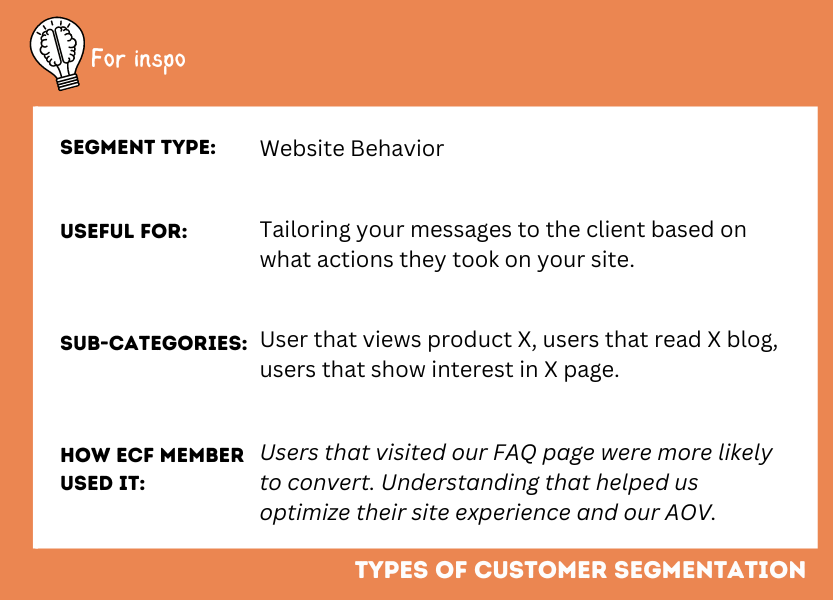
Wrapping Up: Time To Find Your Whales
Customer segmentation isn’t complicated if you focus on your end goals. Think like Dave Senocki; identify your “whales”— the big opportunities in your customer base that yield the highest returns. Don’t get lost in a sea of data.
Remember, this isn’t a one-time exercise. Consistently update your segments based on fresh data and shifts in business objectives.
“We change and refine our segments monthly. Sometimes, we add to them or test others. As for A/B tests, those run regularly to ensure we are constantly optimizing our strategies.” — ECF member
This continuous process is the backbone of effective, targeted marketing campaigns, setting the stage for increased engagement, conversions, and revenue.
Want access to 750+ discussions of segmentation advice?
In the ECF community, you’ll find more practical advice and tested strategies for effective customer segmentation, helping you better understand your customer base. You can learn more about the community or apply to join today.



![15+ Top Black Friday & Cyber Monday Deals for Developers and Designers [2023]](https://wiredgorilla.com/wp-content/uploads/2023/11/15-top-black-friday-cyber-monday-deals-for-developers-and-designers-2023.jpg 1460w, https://wiredgorilla.com/wp-content/uploads/2023/11/15-top-black-friday-cyber-monday-deals-for-developers-and-designers-2023-300x168.jpg 300w, https://wiredgorilla.com/wp-content/uploads/2023/11/15-top-black-friday-cyber-monday-deals-for-developers-and-designers-2023-1024x575.jpg 1024w, https://wiredgorilla.com/wp-content/uploads/2023/11/15-top-black-friday-cyber-monday-deals-for-developers-and-designers-2023-768x431.jpg 768w)